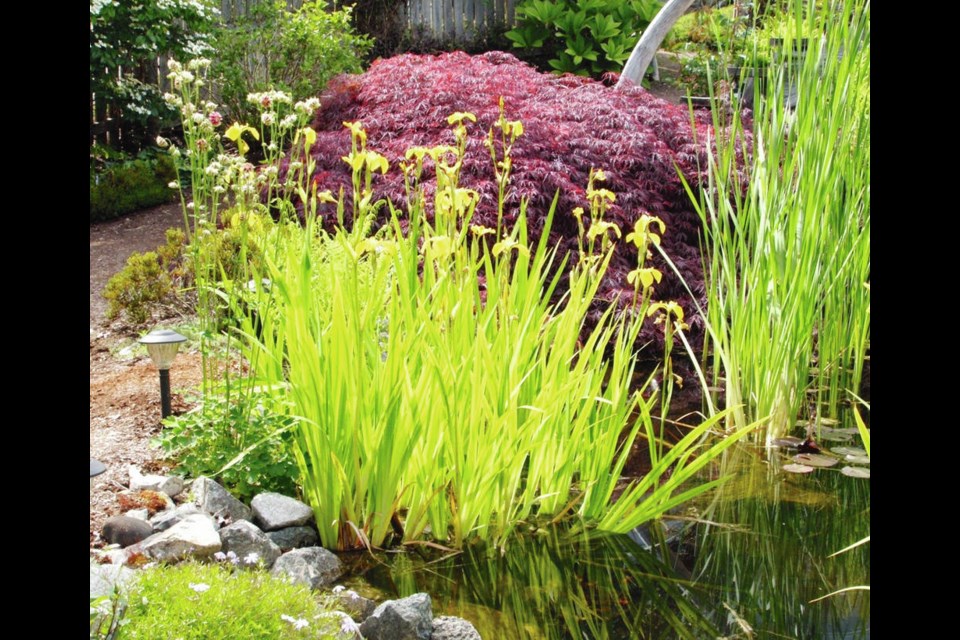Dear Helen: A natural pond on my property has no water in it now, because of the dry spring. It usually contains water until August I’m concerned about drought, but on the other hand this does give me the opportunity to clear out a patch of “yellow flag” iris, which I understand is invasive. What are your thoughts on this?
N.B.
This unusual situation does present an ideal opportunity to remove the iris, which spreads through extensive root systems and by seeds. I would cut the plants back and begin digging out the roots. Wear gloves and protective clothing as protection against a toxic resin in the plants.
The roots form a thick mat. Pieces that break off and remain in the soil can form new plants. If your planting is extensive, dig a little at a time. The Coastal Invasive Species Committee (coastalisc.com) recommends disposal by burning or placing in a thick garbage bag for landfilling. Another useful source of information is the Invasive Species Council of British Columbia (bcinvasives.ca).
If any flowers appear while you are still digging, cut them off before seeds can form. Monitor the area carefully after the digging is finished and remove any new sprouts that appear.
Though it is an attractive ornamental, yellow flag iris (Iris pseudacorus) is an aggressive invader in habitats such as ponds, marshes and other wetlands. Its dense growth replaces native species and impacts wetland wildlife.
Dear Helen: A strange condition has affected my strawberry leaves. They are striped and speckled green and yellow. The only suggested cause I can find is an iron deficiency. What should I do?
H.Y.
The photo you sent shows the leaf veins remaining dark green with areas in between a pale yellow.
Yellowing of leaves between the veins while the veins remain green can be either one of two nutrient deficiencies, depending on the age of the leaves. When the symptoms appear on older leaves, it’s probably a magnesium deficiency. Epson salts (magnesium sulphate) can be used to correct this.
If the interveinal yellowing begins in the youngest leaves and progresses slowly to older foliage, the problem is more likely to be an iron deficiency, which can occur when the soil is not acidic enough for strawberries. Peat moss, fine fir bark or powdered sulphur help to increase acidity.
Dear Helen: Each spring when I dig the soil in our flower beds I find it matted with what looks like fine root fibres. I shake them out and clean up the soil, but it returns the next year. In the fall, I shred our fallen oak leaves and mix them into the soil. The leaves are gone in the spring, but this fibrous stuff remains. What could be causing this?
B.M.
Your photo shows a mass of fine feeder roots that look much like the ones I have to dig out of my vegetable plots every spring. Mine are from the neighbors’ towering forest of mainly cedar trees. The large trees send out feeder roots a surprising distance from the trees. Oak trees can do this too, especially if the tree or trees are mature. As oak trees mature, roots begin to spread out widely.
Dear Helen: Can you suggest a mulching material suited for use under and around plants that require an acidic soil, such as blueberries and camellias?
S.R.
Fine fir bark, peat moss, pine needles and chopped leaves are all commonly used mulches for plants requiring an acidic soil. It is my preference to mix any of these with compost first, for two reasons: A good compost will enhance the nourishment value for the plants and at the same time prevent the formation of a crusted-over layer that sheds water.
Peat moss is especially prone to “caking” over and should not be used alone as a mulch.
Dear Helen: Have you found a way to arrive quickly at solid information on gardening issues online, amid the maze of sometimes conflicting opinion?
C.C.
Online garden research is simplified first by typing a topic in precise language into a search engine and then looking among government and university extension service sites in our regional climate. I’ve found very useful information on the Oregon State University and Washington State University sites, some of it the results of long-term studies on a subject.



